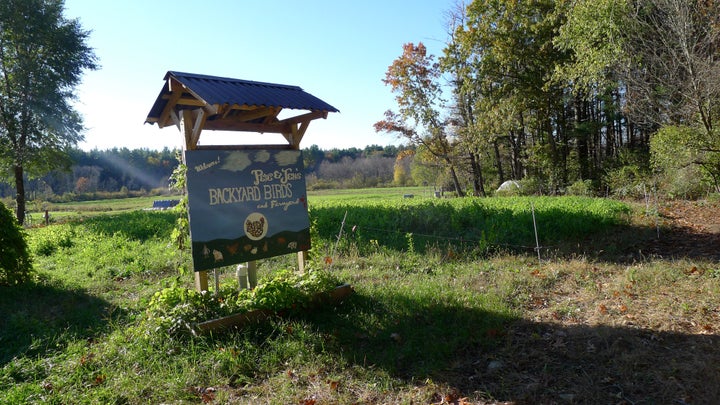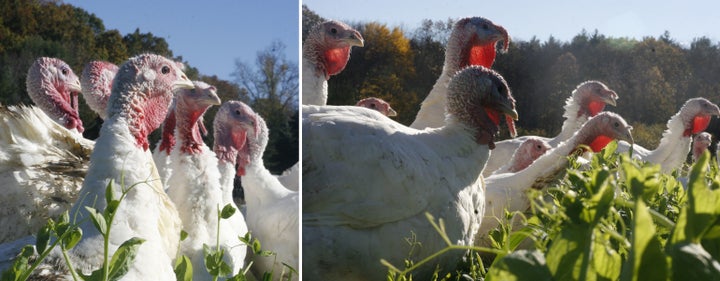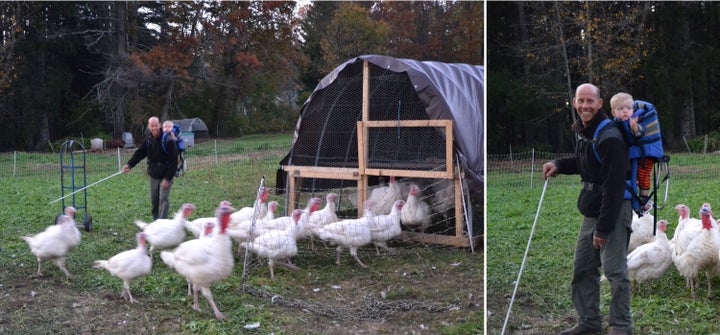Everything Thanksgiving: Get all our Thanksgiving recipes, how-to’s and more!
Thanksgiving means different things to different people, but for a turkey none of it is joyful. This time of year, the bird’s life serves but one purpose: to feed our families in the traditional feast of thanks. No matter which way you slice it, the turkey gets the short end of the deal during the holiday season — but there are some birds that fare better than others. The luckier of the turkeys are those that had the good fortune to have been raised on pasture at a small-scale farm — at least they lived a life in the open air before meeting their end. There is a downfall to the pasture-raised turkey: the steep price tag. A commercial Butterball turkey will cost about $30 for a 20-pound bird, but the price hits closer to $120 for the same size bird raised on open fields.
Despite the price hurdle, the past two decades have given way to a steady rise of small farms that are working to change our current big Ag, factory farm food system. The Butterball scandals brought to light by animal welfare advocacy group Mercy for Animals in 2011 and 2012 is a testament to the importance of that shift (especially since Butterball provides the nation with roughly 13.4 million turkeys each Thanksgiving). The advocacy group revealed the abuse turkeys undergo in factory farming environments. These are horrors that no creature with a beating heart should have to endure, from extreme physical abuse to maggot-infested living conditions — and in some extreme cases, being ground up while still alive. These nightmarish images are reminiscent of Upton Sinclair’s “The Jungle,” but they aren’t stories from the Industrial Revolution; they are happening today.
The severe mistreatment of turkeys paints a dark stain on the entire meal. It’s during these times that the importance of small farms, where humanely raised actually means something, can so clearly be felt — although it is a standard that should be held year round. And it’s why the rare small farm that has slowed down and preserved its principles becomes such a treasured part of the community, such as Pete and Jen’s Backyard Birds in Sudbury, MA.

Pete and Jen’s Backyard Birds began in 2003 by Pete Lowy and Jen Hashley just raising chickens in their, well, backyard for personal use. As time went on, they began selling their excess eggs to friends, meat birds (chickens raised for eating) soon followed, and before they knew it they were raising 200 meat birds at a time and 90 turkeys for the holiday — as well as rabbit, hog and capon. That might not seem like a notable operation in terms of scale, but a closer look at quality tells you that this is significant.
Pete and Jen not only feed their turkeys on pasture, but they’re feasting on fresh pea tendrils too — the kind a trendy New York restaurant will plate with ramps, call it a spring salad and charge you $18 a head for. The birds also eat grain, as well as grit (basically, rocks). They roam in an enclosed area with what is probably the greatest salad bar in all of America. A couple of times a week, once the turkeys have mowed down their salad of fresh greens, they’re moved to another location with fresh tall greens for grazing. Take a look:

This is the idyllic image many people conjure when picturing farm-raised animals, but this is so rarely the case. It’s a somber reality and even Pete Lowy is dismayed at the number of small farms that falsely market their animals as pasture raised. Pete recounted that many farmers will claim to raise animals on pasture, but when you visit the farm you find them tucked away in barns. And that then there are the large farms that are operating at basically the opposite end of the spectrum. Unfortunately, this reality is a result of the many challenges of raising animals in open fields.
It’s incredibly hard to make a living while farming on pasture the “old fashioned way.” That’s one of the reasons that factory farmed animals came to be the norm — and why they are so cheap. The large fields required for grazing take up more land (and therefore are more expensive) than enclosed barns. The work of moving the birds on pasture requires labor (which costs money). And then there are the predators to watch out for. Electric fences will only deter some animals. Coyotes, hawks and weasels can easily sneak in and kill off 50 birds in a night — that’s a huge loss for small farms. The hard work is a sacrifice worth making though — not only for the general well-being of the bird, but for its overall health and taste too — but it comes at a cost for the consumer.
The steep price of pasture-raised turkey is a problem for many Americans. One can easily find a great big Butterball turkey a couple of days before Thanksgiving at any local supermarket for around $1.50 a pound, but getting your hands on a pasture-raised turkey requires planning — all of the birds at Pete and Jen’s have already been sold a month before Thanksgiving — and a deeper pocket, too. A sustainable turkey can easily go for $5-7 a pound: We’re talking about four times more expensive than what you find at the supermarket. But there’s a reason that bird costs so much — and it’s not just because it has the allure of a small farm. Or the fresh diet of pea shoots. The farmers themselves are barely making a profit. Raising a bird on pasture on a small farm scale is just expensive.
Pete broke it down for us: the poult (baby turkey) costs usually $6-10 per pout, which is about 5-10 percent of retail price. But if you take into consideration the possible (and probable) loss of birds while trying to raise the fragile babies, that price shoots up even higher. The loss expected while raising the birds should be less than 5 percent, but many farmers have unexpected issues. Poults can pile on top of each other if they get cold and farmers can end up losing many in a night from a cold spell. Trying to keep them warm with heat lamps is an option, but that hikes up the electricity bill. This is all just to keep the baby birds alive. Then there’s the feeding, which is where it gets really expensive.

Organic grain is about two times the cost of commercial grain. Grain costs can easily make up 30 percent of the retail price — we’re talking about $40 of grain per bird here. Since Pete and Jen also feed their turkeys on pasture, they have to grow the pasture forages too (those pea sprouts don’t just magically appear) — which is another expense. And then there’s the grit that turkeys eat for digestion. Pete said that their 90 turkeys consumed 10 bags of grit this year. At $12 a bag, it adds up. And now comes the trickiest part: processing the bird.
Processing the bird is industry talk for slaughtering the turkey. This is actually trickier than it sounds for small farmers — and not in the emotional sense. Small farmers are faced with the challenge of finding how to process their birds legally, which no matter which way they do it usually costs roughly 15 percent of the retail price of each bird. They can either pay for transportation and processing at the nearest USDA poultry plant of which there are not many — Eastern Massachusetts only has two options — or they can opt to process the birds on their own farm. Each option has its own set of downfalls. Having another party process your bird means paying out even more of your already small profits. But making the decision to process your own bird means serious labor — and lots of paperwork too.
We spoke to Sam Anderson, who is in charge of the Mobile Poultry Processing Unit for Eastern Massachusetts — the MPPU is essentially a licensed slaughter house on wheels that aims to provide small farmers with a legal means to process and sell their birds on their own farms. He said that getting the paperwork in order is hard for farmers. It involves getting permission from the local boards of health, which they’ve found aren’t always so agreeable. But that’s not even the hardest part. Sam says that on processing day, “something always goes wrong and you have to be ready. The hardest stuff is lining up all the logistics, monitoring the temperature of the bird, lining up who’s working and cleaning the whole unit down.” It’s a lot of work. Some farms, like Pete and Jen’s Backyard Birds, are lucky enough to have volunteers come out and be part of the process. But for those who don’t, labor becomes another cost in processing. When the profit margin is so narrow as it is in these small-scale farms, costs like this really matter. And they in turn add to the price of the pasture-raised turkey.
Pete sums it up perfectly: “When you add it all up, a $100 turkey at retail could easily cost us $80. And then when you have a coyote saunter along and take out 10 bird — just before slaughter — there goes a large portion of your profit from growing the turkeys the last four months. Farming is great!” (Did you pick up on that hint of sarcasm?)
Some consumers just simply can’t afford the steep price tags of pasture-raised, small-farm animals, and that is another unfortunate reality of our current food system. And others don’t feel like the price is justified. But if you can afford to pay the difference, you’ll be rewarded with a flavor that will make you grateful for all the pea shoots those birds ate. Customers of Pete and Jen’s Backyard Birds have said that their birds taste way better than anything you could buy at the grocery store. And because it’s more expensive, they just eat less poultry. It’s one of those “less is more” cases.
But making the decision to buy a small-farm pastured raised bird isn’t the only step required to support good farming practices — you have to find the farms that practice what they preach, too. In a world where food labels have become nearly meaningless, it’s disheartening to hear a small-scale, sustainable farmer gripe about the mislabeling happening within his own peers as Pete did. How are those of us who have found their lives fully removed from food production ever to trust what we’re buying? Pete’s advice: Visit the farm. Seeing with your own eyes the conditions of the animals and the farm is the only way to guarantee your food is being grown ethically. And if you can’t visit the farm, look for pictures. Many farms these days have websites, are blogging or are even posting photos on Twitter — Pete and Jen’s Backyard Birds do all three. Look for green fields, happy animals and recent photos, advises Pete, because the proof is in the pasture.
